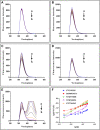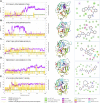Validation of Deep Learning-Based DFCNN in Extremely Large-Scale Virtual Screening and Application in Trypsin I Protease Inhibitor Discovery
- PMID: 35720125
- PMCID: PMC9200220
- DOI: 10.3389/fmolb.2022.872086
Validation of Deep Learning-Based DFCNN in Extremely Large-Scale Virtual Screening and Application in Trypsin I Protease Inhibitor Discovery
Abstract
Computational methods with affordable computational resources are highly desirable for identifying active drug leads from millions of compounds. This requires a model that is both highly efficient and relatively accurate, which cannot be achieved by most of the current methods. In real virtual screening (VS) application scenarios, the desired method should perform much better in selecting active compounds by prediction than by random chance. Here, we systematically evaluate the performance of our previously developed DFCNN model in large-scale virtual screening, and the results show our method has approximately 22 times the success rate compared to the random chance on average with a score cutoff of 0.99. Of the 102 test cases, 10 cases have more than 98 times the success rate of a random guess. Interestingly, in three cases, the prediction success rate is 99 times that of a random guess by a score cutoff of 0.99. This indicates that in most situations after our extremely large-scale VS, the dataset can be reduced 20 to 100 times for the next step of virtual screening based on docking or MD simulation. Furthermore, we have employed an experimental method to verify our computational method by finding several activity inhibitors for Trypsin I Protease. In addition, we also show its proof-of-concept application in de novo drug screening. The results indicate the massive potential of this method in the first step of the real drug development workflow. Moreover, DFCNN only takes about 0.0000225s for one protein-compound prediction on average with 80 Intel CPU cores (2.00 GHz) and 60 GB RAM, which is at least tens of thousands of times faster than AutoDock Vina or Schrödinger high-throughput virtual screening. Additionally, an online webserver based on DFCNN for large-scale screening is available at http://cbblab.siat.ac.cn/DFCNN/index.php for the convenience of the users.
Keywords: DFCNN; Trypsin I Protease; de novo drug screening; deep learning; extremely large-scale virtual screening.
Copyright © 2022 Zhang, Lin, Wei, Zhang, Liao, Wu, Pan and Wu.
Conflict of interest statement
The authors declare that the research was conducted in the absence of any commercial or financial relationships that could be construed as a potential conflict of interest.
Figures







Similar articles
-
DeepBindBC: A practical deep learning method for identifying native-like protein-ligand complexes in virtual screening.Methods. 2022 Sep;205:247-262. doi: 10.1016/j.ymeth.2022.07.009. Epub 2022 Jul 22. Methods. 2022. PMID: 35878751
-
Generating and screening de novo compounds against given targets using ultrafast deep learning models as core components.Brief Bioinform. 2022 Jul 18;23(4):bbac226. doi: 10.1093/bib/bbac226. Brief Bioinform. 2022. PMID: 35724626
-
Accelerating AutoDock Vina with GPUs.Molecules. 2022 May 9;27(9):3041. doi: 10.3390/molecules27093041. Molecules. 2022. PMID: 35566391 Free PMC article.
-
A review of deep learning methods for ligand based drug virtual screening.Fundam Res. 2024 Mar 11;4(4):715-737. doi: 10.1016/j.fmre.2024.02.011. eCollection 2024 Jul. Fundam Res. 2024. PMID: 39156568 Free PMC article. Review.
-
Current trends in computer aided drug design and a highlight of drugs discovered via computational techniques: A review.Eur J Med Chem. 2021 Nov 15;224:113705. doi: 10.1016/j.ejmech.2021.113705. Epub 2021 Jul 15. Eur J Med Chem. 2021. PMID: 34303871 Review.
Cited by
-
Revolutionizing GPCR-ligand predictions: DeepGPCR with experimental validation for high-precision drug discovery.Brief Bioinform. 2024 May 23;25(4):bbae281. doi: 10.1093/bib/bbae281. Brief Bioinform. 2024. PMID: 38864340 Free PMC article.
-
DeepBindGCN: Integrating Molecular Vector Representation with Graph Convolutional Neural Networks for Protein-Ligand Interaction Prediction.Molecules. 2023 Jun 10;28(12):4691. doi: 10.3390/molecules28124691. Molecules. 2023. PMID: 37375246 Free PMC article.
References
LinkOut - more resources
Full Text Sources

